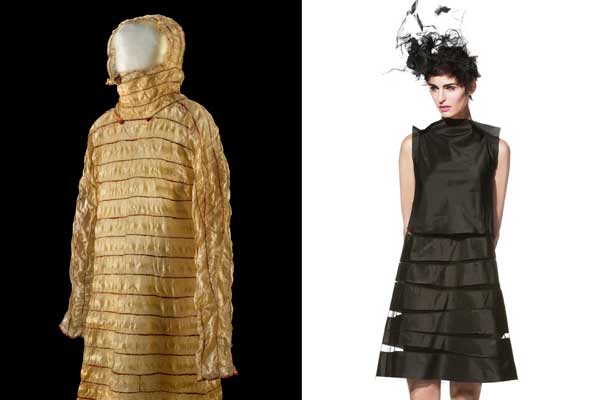
Fashion and The Field Museum Collection: Maria Pinto pairs artifacts—such as this Inuit raincoat, left, stitched from seal intestines—with Pinto's contemporary designs, right.
What’s a growing trend in fashion? The museum collaboration. After last year’s blockbuster retrospective of designs by the late Alexander McQueen at New York’s Metropolitan Museum of Art, major institutions in cities across the country—including, recently, Denver and San Francisco—have been looking at fashion’s contemporary ties to history and (big C) culture.
Last Friday, the Field Museum opened a mini-exhibition that tests similar sartorial waters with Fashion and The Field Museum Collection: Maria Pinto. The museum gave the Chicago-based designer—who locals know as a go-to outfitter for fashion-forward professional women, but who the rest of the world knows as one of the First Lady’s preferred dressmakers—free reign to select pieces from its vast collection of artifacts. From there, Pinto wove loose stories—an absence of signage leaves viewers to connect most of the dots—about how the garments relate to present-day fashion, using a few of her own designs as examples.
On the afternoon of the exhibit’s debut, I talked to Pinto about the collaboration with the Field Museum, how the experience could influence her next collection (which she predicts will be released next year), and the museum fashion retrospective of her dreams.
Did you know anything about the origins of these garments when you first saw them?
Nothing was planned in advance. There was this sense of putting my designs alongside these [historical] objects. But when it was time to decide what to do, and how to present it, the Field left it to me. Alaka [Wali, the museum’s curator of North American anthropology] gave me such a privilege to do what I wanted.
At first, we were working from images, and over a vast collection, until we had about 100 [objects]. Pieces were edited out because they have sacred significance or because they were too fragile. Little by little, things fell away. They left it to me to build vignettes and stories. I brought my pieces, and it all laid out perfectly. It was a seamless editing process.
Was there any information about what they were made of—with the seal-intestine raincoat, for instance?
When I saw the piece, I thought it was really intriguing—not even knowing it was seal intestine. I just thought it was beautiful and interesting. When they told me [what it was made of], it was like, "Whoa, that’s wild!"
Do you think the makers were only thinking about function, or about aesthetics, too?
I think they really cared about how these things looked. They’re too beautiful for them to not have. Like the jacket’s red thread. They might have only had red thread, but it was too well done and well crafted for the culture to not have had an interest in beauty.
What story would your garments tell someone who sees them in the Field 200 years from now?
I don’t know. I hope they’d say, ‘Wow, this is timeless and cool and I still want to wear it.’
Do you think this experience or these objects could influence your next collection?
I think always, everything we see self-consciously informs what we do. The whole experience really will be reflected in some way or another in my work.
Can you give us an idea of what the new collection will look like?
It’s too soon to really formulate the idea.
If you could curate another museum exhibition of another designer’s work, whom would you choose?
What I would like to show is [Madeleine] Vionnet meets Azzedine Alaïa. Vionnet was the first designer to drape on the bias. Once you study her, you can see so much of where fashion comes from. Alaïa really researched her work, and he’s a master in the way he cuts and shapes the details [of a garment]. I’m surprised it hasn’t already happened.
Fashion and the Field Museum Collection: Maria Pinto runs through June 16, 2013. For info, visit fieldmuseum.org.
Photography: (coat) John Weinstein; (dress) Nathan Beckner


